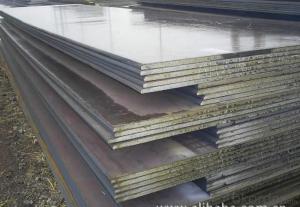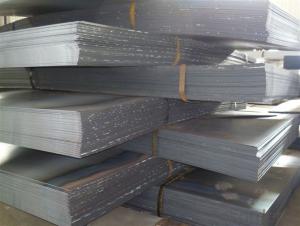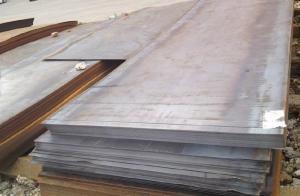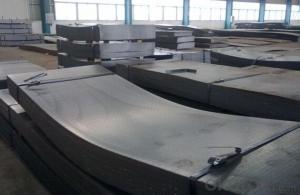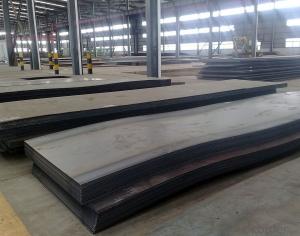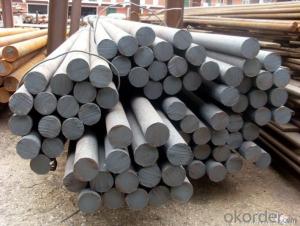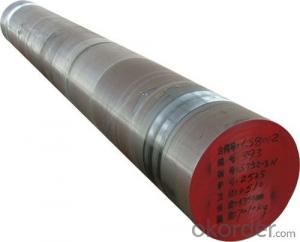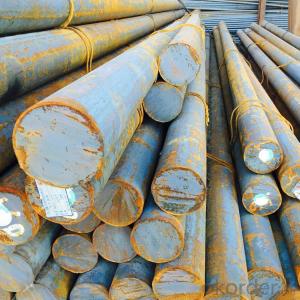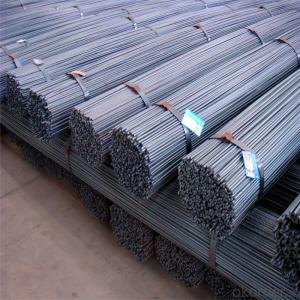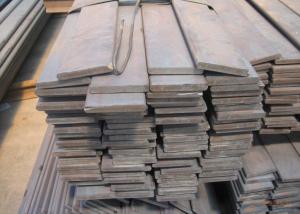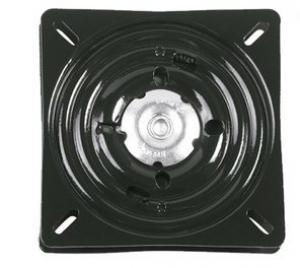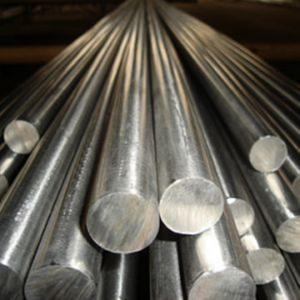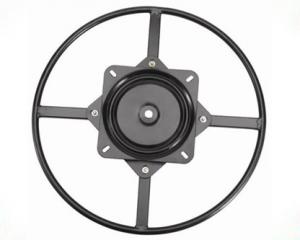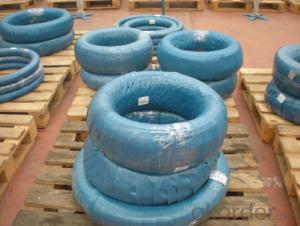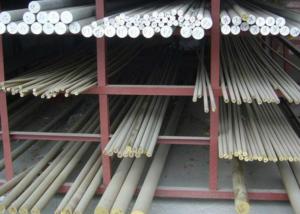5CrNiMoV Cold Rolled Steel Plate Different Types of Steel Sheet
- Loading Port:
- Tianjin
- Payment Terms:
- TT or LC
- Min Order Qty:
- 25 m.t.
- Supply Capability:
- 100000 m.t./month
OKorder Service Pledge
OKorder Financial Service
You Might Also Like
Item specifice
5CrNiMoV Cold Rolled Steel Sheet Prices Different Types of Steel Plate
| C | Si | P | S | yield Strength MAp | Tensile strength MAp | Elongation % | |
A36 | 0.24 | 0.4 | 0.045 | 0.03 | 250 | 400-520 | 26 | |
| C | Si | Mn | P | S | Cu |
|
|
A283 | ≤0.27 | 0.15-0.4 | ≤0.9 | ≤0.035 | ≤0.04 | ≥0.2 |
|
|
Thickness: | 6mm, 8mm, 12mm, 16mm, 20mm, 25mm, 30mm, 50mm, 80mm, 100mm, 150mm, 200mm | |||||||
Width: | 1500mm, 1800mm, 2000mm, 2200mm, 2500mm | |||||||
Length: | 6000mm, 8000m, can cut to width and length | |||||||
Packing: | according to customer‘s require or export’s standard | |||||||
Delivery time: | 7 days for stock sizes, 20-25 days for new production sizes | |||||||
Related Products Overviews
Product Name | Typical Grades | Diameter(mm) | Standard Adopted |
Carbon Steel | 20 (1020/S20C/C22) |
Ø16-Ø300 |
GB/SAE/ JIS/DIN |
40 (1040/S40C/C40) | |||
45 (1045/S45C/C45) | |||
Bearing Steel | GCr9 (51100/SUJ1) |
Ø12-Ø250 | |
GCr15 (52100/SUJ2/100Gr6) | |||
GCr9SiMn (A485-Gr.1/SUJ3) | |||
Cr-Mo Steel | 20Cr (5120/SCr420H/20Cr4) |
Ø12-Ø250 | |
40Cr (5140/SCr440/41Cr4) | |||
42CrMo(4140/SCM440/42CrMo4) | |||
Gear Steel | 20CrNiMo |
Ø16-Ø600 | |
20CrMn(5115/SMnC420/20MnCr5) | |||
20CrNiMo(8620/SNCM220/20CrMiMo2) |
CNBM International are mainly concentrate on Cement, Glass, Iron and Steel, Ceramics industries and devotes herself for supplying high quality series of refractories as well as technical consultancies and logistics solution.
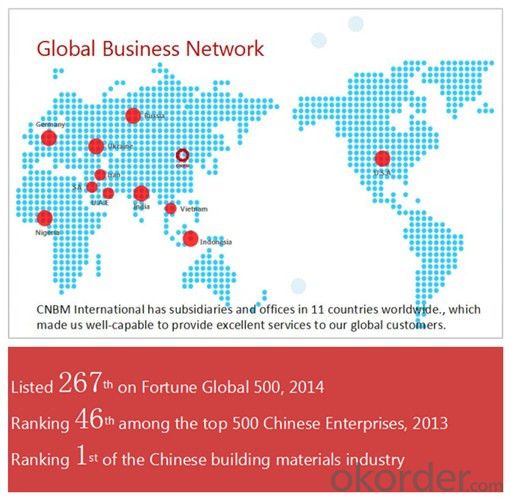
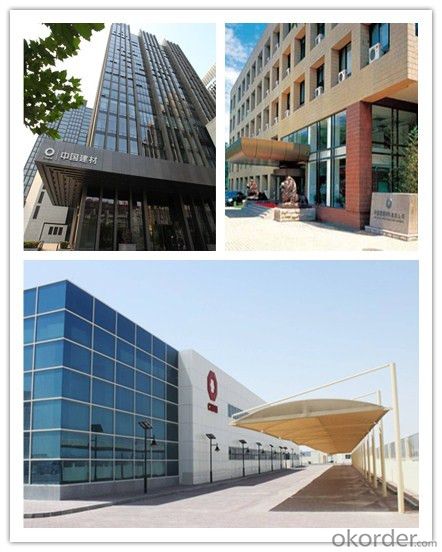
After-sale service | 1. CNBM provides the services and support you need for every step of our cooperation. We’re the business partners you can trust; you can relax and get on with doing business. 2. For any problem, please kindly contact us at any your convenient time, we’ll reply you in our first priority within 24 hours |
Advantages
| 1. Industry experience over 20 years. 2. Shipment of goods -More than 70 countries worldwide. 3. The most convenient transport and prompt delivery. 4. Competitive price with best service. 5. High technical production line with top quality products. 6. High reputation based on best quality products. |
| Packaging | Sea worthy packing /as per customer's packing instruction |
| Delivery | 15 ~ 40 days after receiving the deposit |
- Q:How does special steel contribute to the magnetic properties of products?
- The unique composition and structure of special steel contribute to the magnetic properties of products. This type of steel, also known as alloy steel, contains specific elements like nickel, chromium, manganese, and molybdenum, which alter its magnetic behavior. Depending on the desired application, these elements can either enhance or suppress the magnetism of the steel. For example, the addition of nickel increases the magnetic permeability of steel, making it more responsive to magnetic fields. This characteristic is extremely beneficial in applications such as transformers, where efficient magnetic flux conduction is necessary. Similarly, the inclusion of other magnetic elements like cobalt or iron can also improve the magnetic properties of special steel. On the other hand, certain elements can reduce or eliminate the magnetic qualities of steel. Chromium, for instance, is famous for its non-magnetic properties. When chromium is added to steel, it decreases its magnetic permeability, making it suitable for applications that require non-magnetic features, like medical equipment or electronics. Moreover, the magnetic properties of special steel are influenced by its structure. Heat treatment processes can manipulate the crystalline structure of the steel, thereby affecting its magnetization. For instance, annealing the steel can increase the size of the crystal grains, resulting in reduced magnetization. Conversely, cold working or quenching the steel can create a finer grain structure, enhancing its magnetic properties. In summary, by incorporating specific elements and manipulating its structure, special steel contributes to the magnetic properties of products. Depending on the application requirements, these elements can either enhance or suppress magnetism. The ability to tailor the magnetic properties of special steel makes it highly valuable in industries such as telecommunications, energy, and electronics.
- Q:How does special steel contribute to the manufacturing of springs for automotive applications?
- The unique properties and characteristics of special steel play a crucial role in the manufacturing of springs for automotive applications. Springs are essential components in automobiles as they provide suspension and shock absorption, which ensures a comfortable and smooth ride. One of the main advantages of using special steel in spring manufacturing is its high strength and durability. Springs are constantly subjected to stress and repetitive loading, but special steel can withstand these forces without deforming or breaking due to its exceptional strength. This property ensures that the springs can maintain their shape and performance over extended periods of use, guaranteeing reliable functionality. Special steel also offers excellent fatigue resistance, a vital characteristic for automotive springs. Fatigue occurs when a material weakens and eventually fails after repeated loading and unloading cycles. However, special steel is specifically designed to withstand fatigue, allowing the springs to endure constant pressure and stress without prematurely failing. Furthermore, special steel provides superior corrosion resistance, which is particularly important for automotive springs. Cars are exposed to various environmental elements, such as moisture, road salt, and chemicals, which can lead to corrosion and deterioration of the springs. By utilizing special steel with enhanced corrosion resistance, manufacturers can ensure that the springs have a longer lifespan and maintain their performance even in harsh conditions. Additionally, special steel offers versatility in terms of its composition and properties. Manufacturers can choose from a wide range of special steel alloys, each with its own unique characteristics, to meet specific requirements. This flexibility in material selection empowers manufacturers to design and produce springs that are tailored to the specific needs of automotive applications. Some alloys offer greater elasticity, allowing the springs to flex and absorb shocks more effectively, while others provide higher hardness, enhancing the springs' load-bearing capacity. In conclusion, special steel significantly contributes to the manufacturing of springs for automotive applications by providing high strength, durability, fatigue resistance, corrosion resistance, and versatility. These properties enable the production of reliable, long-lasting springs that ensure optimal suspension, shock absorption, and overall performance in vehicles.
- Q:How does the heat treatment process affect special steel?
- The heat treatment process can significantly impact the properties of special steel. It involves heating the steel to a specific temperature and then cooling it in different ways to achieve desired hardness, strength, and other mechanical properties. By carefully controlling the heating and cooling rates, the heat treatment process can alter the microstructure of the steel, allowing for the formation of various phases and structures. This can result in improved hardness, toughness, and wear resistance, making the special steel more suitable for specific applications. Additionally, heat treatment can also relieve internal stresses and improve dimensional stability, enhancing the overall performance and durability of the special steel.
- Q:What are the non-destructive testing methods used for special steel?
- Special steel can be evaluated for flaws or defects using various non-destructive testing (NDT) methods. These techniques are designed to identify issues in the material without causing any harm. Ultrasonic testing is a prevalent NDT method for special steel. It involves transmitting high-frequency sound waves through the steel and analyzing the reflected echoes. By measuring the time it takes for the sound waves to travel through the steel and return, technicians can determine the material's thickness, density, and internal structure. This method is highly effective in detecting cracks, voids, or inclusions in the steel. Magnetic particle testing is another commonly used NDT method for special steel. It requires applying a magnetic field to the steel's surface and coating it with magnetic powder. Any irregularities or defects in the steel will result in magnetic flux leakage, causing the magnetic particles to cluster and create visible indications. This technique is particularly useful in identifying surface cracks or discontinuities. Liquid penetrant testing is frequently employed for NDT of special steel. It entails applying a liquid dye or fluorescent substance to the steel's surface. The dye penetrates any surface cracks or defects, and after a specified time, excess dye is removed. A developer is then used to draw out the dye from any flaws, making them visible under UV light. This method effectively detects surface discontinuities and is commonly utilized in the aerospace and automotive industries. Radiographic testing is another NDT method applicable to special steel. This procedure involves exposing the steel to X-rays or gamma rays and capturing the resulting image on film or a digital detector. Technicians can analyze the radiographic image to identify internal flaws like cracks, voids, or inclusions in the steel. This method is particularly advantageous for thicker sections of steel or situations where accessing the material is challenging. In conclusion, non-destructive testing methods, including ultrasonic testing, magnetic particle testing, liquid penetrant testing, and radiographic testing, are frequently employed for special steel. These methods ensure the detection of flaws or defects without causing any damage to the material, thereby ensuring its integrity and reliability.
- Q:What are the main applications of special steel in the power distribution industry?
- Special steel is extensively used in the power distribution industry for various applications. Some of the main applications include manufacturing of transmission towers, electrical poles, and conductors. Special steel's high strength, durability, and corrosion resistance make it ideal for these critical components, ensuring reliable power transmission and distribution infrastructure. Additionally, special steel is used in the production of electrical transformers, switchgear components, and power generation equipment, further enhancing the efficiency and reliability of the power distribution systems.
- Q:What are the different methods of improving the corrosion resistance of special steel?
- There are several methods for improving the corrosion resistance of special steel. One common approach is the addition of alloying elements such as chromium, nickel, or molybdenum, which form a protective oxide layer on the steel surface. Another method involves surface treatments like passivation or electroplating, which create a barrier against corrosion. Additionally, applying protective coatings such as paints or powder coatings can also enhance the steel's resistance to corrosion. Finally, proper maintenance practices like regular cleaning, drying, and oiling can help prevent corrosion and ensure the longevity of special steel.
- Q:What are the different construction grades of special steel?
- In various industries and applications, special steel with different construction grades is utilized. These grades are specifically engineered to offer superior strength, durability, and resistance to corrosion and other environmental factors. Some well-known construction grades of special steel include: 1. Mild Steel: This grade is widely used in construction and is considered the most basic. It has a low carbon content, making it easy to work with and weld. Mild steel is suitable for applications that require moderate strength and durability. 2. High-Strength Low-Alloy (HSLA) Steel: HSLA steel is a type of special steel that contains small amounts of alloying elements like copper, nickel, and vanadium. This grade provides higher strength and improved formability compared to mild steel. It is commonly used in structural applications where a higher strength-to-weight ratio is needed. 3. Weathering Steel: Also referred to as Cor-Ten steel, weathering steel is a special grade that develops a protective layer of rust when exposed to the elements. This layer acts as a barrier against further corrosion, making it ideal for outdoor structures. Weathering steel is commonly used in bridges, buildings, and other architectural applications. 4. Stainless Steel: Stainless steel is a corrosion-resistant alloy that contains at least 10.5% chromium. It offers exceptional resistance to corrosion, heat, and chemicals, making it suitable for a wide range of construction applications. Stainless steel is commonly used in building facades, roofing, and structural components. 5. Tool Steel: Tool steel is a special grade specifically designed for manufacturing tools, dies, and molds. It possesses high hardness, wear resistance, and toughness properties, making it suitable for applications that involve cutting, shaping, and forming materials. 6. Alloy Steel: Alloy steel is a special grade that incorporates additional alloying elements like manganese, silicon, nickel, and chromium. This grade provides enhanced strength, toughness, and wear resistance compared to carbon steel. Alloy steel finds common usage in machinery, equipment, and components subjected to high stress and wear. These examples highlight the various construction grades of special steel. Each grade possesses unique properties and is chosen based on the specific requirements of the application.
- Q:What are the common applications of special steel in the manufacturing industry?
- Special steel is commonly used in the manufacturing industry for a variety of applications including the production of tools, machinery parts, automotive components, construction materials, and aerospace equipment. Its high strength, durability, corrosion resistance, and heat resistance make it ideal for demanding environments and critical applications where regular steel may not suffice.
- Q:What are the main characteristics of structural steel?
- Structural steel, renowned for its exceptional properties and characteristics, has become a widely utilized material in the construction industry. Its main attributes encompass: 1. Strength: Boasting an impressive strength-to-weight ratio, structural steel endures heavy loads and forces without compromising its structural integrity. As a result, it proves to be a durable and dependable choice for a multitude of construction applications. 2. Flexibility: The malleability of structural steel lends itself to effortless fabrication into diverse shapes and sizes, catering to specific project needs. This inherent flexibility empowers architects and engineers to fashion distinctive and groundbreaking structures. 3. Fire resistance: Steel's remarkable resistance to fire renders it an invaluable selection for buildings where fire protection holds utmost importance, particularly in towering edifices. Being non-combustible, it neither ignites nor aids the spread of flames. 4. Sustainability: With its high recyclability, structural steel emerges as an environmentally conscious material. At the end of its lifespan, it can be repurposed or reused, minimizing waste and conserving precious natural resources. Moreover, energy-efficient designs can be incorporated into steel structures, further contributing to sustainability. 5. Cost-effectiveness: Structural steel presents an economically viable solution for construction ventures. Its widespread availability renders it more affordable compared to alternative building materials. Furthermore, its strength and durability translate into reduced expenses for maintenance and repairs in the long run. 6. Expedited construction: The fabrication of steel structures off-site, followed by swift on-site erection, expedites construction timelines. This expeditious process curtails project duration and costs, making structural steel an ideal choice for time-sensitive undertakings. 7. Design versatility: The robustness and flexibility of structural steel facilitate the realization of a broad spectrum of architectural designs. With minimal support columns, large and open spaces can be achieved, granting architects unparalleled freedom in their creations. Consequently, steel emerges as an enticing option for numerous building types, encompassing commercial, industrial, and institutional structures. In conclusion, the main attributes of structural steel encompass strength, flexibility, fire resistance, sustainability, cost-effectiveness, expedited construction, and design versatility. These qualities render it the preferred choice for construction projects worldwide.
- Q:What are the applications of special steel in the agriculture supply chain?
- Special steel has various applications in the agriculture supply chain, including the manufacturing of agricultural machinery and equipment such as tractors, harvesters, and irrigation systems. It is also used in the production of storage containers, silos, and fencing materials for farms. Additionally, special steel is utilized for constructing infrastructure like bridges, railings, and support structures in agricultural facilities. Overall, the use of special steel in the agriculture supply chain ensures durability, strength, and longevity of essential equipment and structures, enhancing efficiency and productivity in the farming industry.
1. Manufacturer Overview |
|
|---|---|
| Location | |
| Year Established | |
| Annual Output Value | |
| Main Markets | |
| Company Certifications | |
2. Manufacturer Certificates |
|
|---|---|
| a) Certification Name | |
| Range | |
| Reference | |
| Validity Period | |
3. Manufacturer Capability |
|
|---|---|
| a)Trade Capacity | |
| Nearest Port | |
| Export Percentage | |
| No.of Employees in Trade Department | |
| Language Spoken: | |
| b)Factory Information | |
| Factory Size: | |
| No. of Production Lines | |
| Contract Manufacturing | |
| Product Price Range | |
Send your message to us
5CrNiMoV Cold Rolled Steel Plate Different Types of Steel Sheet
- Loading Port:
- Tianjin
- Payment Terms:
- TT or LC
- Min Order Qty:
- 25 m.t.
- Supply Capability:
- 100000 m.t./month
OKorder Service Pledge
OKorder Financial Service
Similar products
New products
Hot products
Hot Searches
Related keywords
